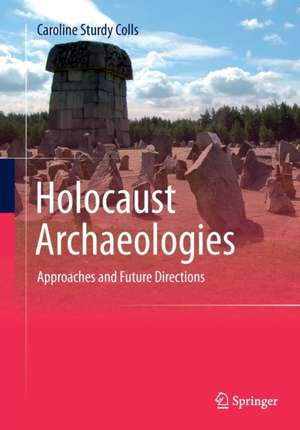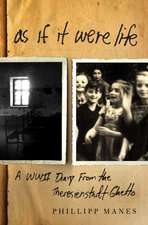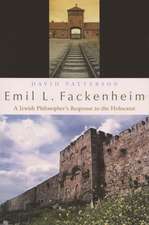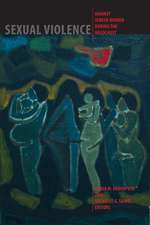Holocaust Archaeologies: Approaches and Future Directions
Autor Caroline Sturdy Collsen Limba Engleză Paperback – 8 oct 2016
| Toate formatele și edițiile | Preț | Express |
|---|---|---|
| Paperback (1) | 489.42 lei 6-8 săpt. | |
| Springer International Publishing – 8 oct 2016 | 489.42 lei 6-8 săpt. | |
| Hardback (1) | 915.77 lei 6-8 săpt. | |
| Springer International Publishing – 11 mar 2015 | 915.77 lei 6-8 săpt. |
Preț: 489.42 lei
Nou
Puncte Express: 734
Preț estimativ în valută:
93.69€ • 96.36$ • 77.73£
93.69€ • 96.36$ • 77.73£
Carte tipărită la comandă
Livrare economică 19 februarie-05 martie
Preluare comenzi: 021 569.72.76
Specificații
ISBN-13: 9783319344959
ISBN-10: 3319344951
Pagini: 375
Ilustrații: XVII, 358 p. 148 illus., 130 illus. in color.
Dimensiuni: 178 x 254 x 20 mm
Greutate: 0.65 kg
Ediția:Softcover reprint of the original 1st ed. 2015
Editura: Springer International Publishing
Colecția Springer
Locul publicării:Cham, Switzerland
ISBN-10: 3319344951
Pagini: 375
Ilustrații: XVII, 358 p. 148 illus., 130 illus. in color.
Dimensiuni: 178 x 254 x 20 mm
Greutate: 0.65 kg
Ediția:Softcover reprint of the original 1st ed. 2015
Editura: Springer International Publishing
Colecția Springer
Locul publicării:Cham, Switzerland
Cuprins
Part I: Background.- Chapter 1: Introduction.- Chapter 2: Context.- Chapter 3: Reading the Landscape.- Part II: Methodologies in Holocaust Archaeology.- Chapter 4: Ethical Issues and Project Design.- Chapter 5: Desk-Based Investigation.- Chapter 6: Above-Ground Investigations.- Chapter 7: Below-Ground Investigations.- Part III: Archaeologies of the Holocaust.- Chapter 8: Physical Evidence of the Holocaust.- Chapter 9: Archaeologies of Oppression, Deception and Resistance.- Chapter 10: Archaeologies of Life, Work and Death.- Chapter 11: Traces of Memory.- Chapter 12: (Re-)Presenting the Holocaust.
Recenzii
“Sturdy Colls’ crucial and ambitious volume has provided the foundation for a desperately needed practical and ethical protocol for archaeological investigation of Holocaust sites–one that will aid students and archaeologists considering entering the field, allow educators to keep their courses timely and relevant, inform interested laypeople, and spur debate about the future of Holocaust archaeology.” (Robert M. Ehrenreich, Holocaust and Genocide Studies, Vol. 29 (3), December, 2015)
“In her just published book, ‘Holocaust Archeologies: Approaches and Future Directions,’ Sturdy Colls lays groundwork for the emerging field of non-invasive investigations of genocide sites. … Sturdy Colls’s 358-page volume is both a field manual for researchers, and a first-hand account of the herculean efforts required to conduct even a survey of Holocaustera grounds.” (Matt Lebovic, The Times of Israel, timesofisrael.com, April, 2015)
“In her just published book, ‘Holocaust Archeologies: Approaches and Future Directions,’ Sturdy Colls lays groundwork for the emerging field of non-invasive investigations of genocide sites. … Sturdy Colls’s 358-page volume is both a field manual for researchers, and a first-hand account of the herculean efforts required to conduct even a survey of Holocaustera grounds.” (Matt Lebovic, The Times of Israel, timesofisrael.com, April, 2015)
Notă biografică
Dr Caroline Sturdy Colls is an Associate Professor at Staffordshire University specialising in forensic and Holocaust archaeology. She is also the Research Lead and founder of the Centre of Archaeology at the same institution. Her research focuses on the application of interdisciplinary approaches to the investigation of Holocaust landscapes. As part of this research, she completed the first archaeological surveys of the former extermination camp at Treblinka (Poland), the sites pertaining to the slave labour programme in Alderney (the Channel Islands) and the former Semlin Judenlager and Anhaltlager (Serbia). She has published extensively in Holocaust and forensic archaeology. Her research has received international media attention via television documentaries and radio programmes aired in Europe and the US. She also acts as a Scientific Advisor for Kamp Westerbork and sits on the NWO Holocaust Archaeology Group. Caroline is also a Consultant for the Polish-German Reconciliation Foundation, searching for mass graves of the Holocaust across Poland. Caroline is also a member of the Forensic Archaeology Expert Panel and regularly undertakes forensic search and recovery work with UK Police forces. Her particular interests in this field include the application of forensic archaeological methods to the investigation of cold cases and socio-historic conflicts. She is also a Member of the Institute For Archaeologists (MIFA) and a Member and Assessor for the Chartered Society of Forensic Sciences (MCSFS). As the Research Lead of the Centre of Archaeology, her interest in archaeology goes beyond the recent past and she has managed a number of large-scale research and consultancy projects across Europe.
Textul de pe ultima copertă
Holocaust Archaeologies: Approaches and Future Directions aims to move archaeological research concerning the Holocaust forward through a discussion of the variety of the political, social, ethical and religious issues that surround investigations of this period and by considering how to address them. It considers the various reasons why archaeological investigations may take place and what issues will be brought to bear when fieldwork is suggested. It presents an interdisciplinary methodology in order to demonstrate how archaeology can (uniquely) contribute to the history of this period. Case examples are used throughout the book in order to contextualise prevalent themes and a variety of geographically and typologically diverse sites throughout Europe are discussed. This book challenges many of the widely held perceptions concerning the Holocaust, including the idea that it was solely an Eastern European phenomena centred on Auschwitz and the belief that othersites connected to it were largely destroyed or are well-known. The typologically , temporally and spatial diverse body of physical evidence pertaining to this period is presented and future possibilities for investigation of it are discussed. Finally, the volume concludes by discussing issues relating to the “re-presentation” of the Holocaust and the impact of this on commemoration, heritage management and education. This discussion is a timely one as we enter an age without survivors and questions are raised about how to educate future generations about these events in their absence.
Caracteristici
Focuses on three main case study sites: Treblinka in Poland, Semlin Camp in Serbia and Alderney in the UK Channel Islands Challenges many of the widely held perceptions of Holocaust archaeology and history Considers conservation of Holocaust sites, in the context of the debates of commodification, authenticity and restoration Includes supplementary material: sn.pub/extras












